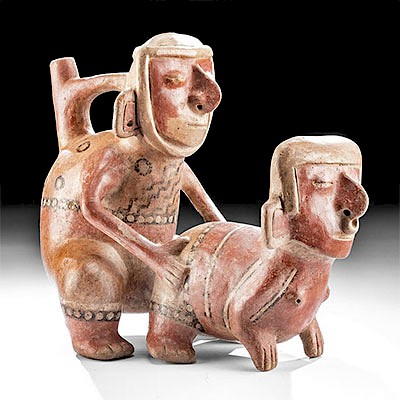Fine Cocle Macaracas Polychrome Pedestal Plate
Lot 46f
About Seller
Artemis Gallery
686 S Taylor Ave, Ste 106
Louisville, CO 80027
United States
Selling antiquities, ancient and ethnographic art online since 1993, Artemis Gallery specializes in Classical Antiquities (Egyptian, Greek, Roman, Near Eastern), Asian, Pre-Columbian, African / Tribal / Oceanographic art. Our extensive inventory includes pottery, stone, metal, wood, glass and textil...Read more
Estimate:
$1,800 - $2,700
Absentee vs Live bid
Two ways to bid:
- Leave a max absentee bid and the platform will bid on your behalf up to your maximum bid during the live auction.
- Bid live during the auction and your bids will be submitted real-time to the auctioneer.
Bid Increments
| Price | Bid Increment |
|---|---|
| $0 | $25 |
| $300 | $50 |
| $1,000 | $100 |
| $2,000 | $250 |
| $5,000 | $500 |
| $10,000 | $1,000 |
| $20,000 | $2,500 |
| $50,000 | $5,000 |
| $100,000 | $10,000 |
| $200,000 | $20,000 |
About Auction
By Artemis Gallery
Jan 30, 2020
Set Reminder
2020-01-30 10:00:00
2020-01-30 10:00:00
America/New_York
Bidsquare
Bidsquare : Pre-Columbian | Tribal | Ethnographic
https://www.bidsquare.com/auctions/artemis-gallery/pre-columbian-tribal-ethnographic-4830
Featuring ancient and ethnographic art from around the world, including Pre-Columbian, Native American, African / Tribal, Oceanic, Ethnographic, Spanish Colonial, Fossils, Fine Art, much more. Artemis Gallery info@artemisgallery.com
Featuring ancient and ethnographic art from around the world, including Pre-Columbian, Native American, African / Tribal, Oceanic, Ethnographic, Spanish Colonial, Fossils, Fine Art, much more. Artemis Gallery info@artemisgallery.com
- Lot Description
Pre-Columbian, Central America, Panama, Gran Cocle, Macaracas style, ca. 800 to 1000 CE. A beautiful, hand-built pottery pedestal plate with a broad foot and a tapered pedestal neck surmounted by a shallow dish with a thick rim. The orange-slipped vessel features a black-and-red program along the pedestal and dish underside with abstract pointed forms beneath the dish, broad diamonds and trapezoids on the foot and pedestal, and red rings and stripes interspersed. The basin surface adds in a fourth color - purple - to accentuate the highly abstract standing saurian figure presented in the center that has bulging eyes above a narrow mouth, bent arms with clawed fingers, delineated feet with lengthy toes, and serrated stingray barbs projecting from its body. An interesting and highly perplexing example of Cocle figural iconography. Size: 9.5" W x 7.7" H (24.1 cm x 19.6 cm)
According to scholar Samuel Kirkland Lothrop, "The Gran Cocle culture is a Pre-Columbian archaeological culture that gets its name from the area from which it was based, the now present-day Cocle province of Panama. The Gran Cocle term applies to a loosely studied group of Native American sub-cultures in this region, identified by their pottery styles. The overall period spans a time from 150 B.C. to the end in the 16th century A.D. upon Spanish contact. The most ancient culture is the La Mula period from 150 B.C. to 300 A.D. The La Mula and later Monagrillo and Tonosi pottery styles are identified by their use of three paint colors which were black, red and white (or cream). The later Cubita style saw the emergence of the use of four colors. The styles of Conte, Macaracas and Joaquin added purple to their palette and this hue ranged from grayish tones to red purple. The use of purple disappeared in the subsequent styles of Parita and El Altillo and the paint style reverted back to the use of three colors. Most notable in the artistic renderings are the overt use of geometric designs." (For more information, see Armand Labbe, "Guardians of The Life Stream: Shamans, Art and Power in Prehispanic Central Panama" - Bowers Museum of Cultural Art, University of Washington Press, 1995.)
For a stylistically similar example of the figural iconography, please see: Labbe, Armand J. "Guardians of the Life Stream: Shamans, Art and Power in Prehispanic Central Panama." The University of Washington Press, 1995, p. 40, fig. 38.
Provenance: private New York, New York, USA collection; ex-private Dallas, Texas, USA collection
All items legal to buy/sell under U.S. Statute covering cultural patrimony Code 2600, CHAPTER 14, and are guaranteed to be as described or your money back.
A Certificate of Authenticity will accompany all winning bids.
We ship worldwide and handle all shipping in-house for your convenience.
#152703Neck and foot repaired from multiple pieces, with minor restoration in some areas, and resurfacing and overpainting along new material and break lines. Minor abrasions to rim, basin, neck, and foot, with light fading to areas of original pigment, light encrustations, and a couple of stabilized fissures. Light earthen deposits, nice manganese blooms, and great traces of original pigment throughout.Condition
- Shipping Info
-
All shipping is handled in-house for your convenience. Your invoice from Artemis Gallery will include shipping calculation instructions. If in doubt, please inquire BEFORE bidding for estimated shipping costs for individual items.
-
- Buyer's Premium



 EUR
EUR CAD
CAD AUD
AUD GBP
GBP MXN
MXN HKD
HKD CNY
CNY MYR
MYR SEK
SEK SGD
SGD CHF
CHF THB
THB
















